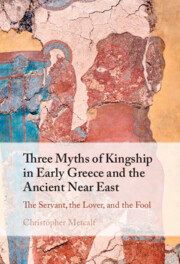Refine search
Actions for selected content:
330 results
Chapter 9 - Twenty Questions about Employment Testing Bias and Unfairness in Greece
-
-
- Book:
- Global Perspectives on the Definition, Assessment, and Reduction of Bias and Unfairness in Employment Testing
- Published online:
- 04 November 2025
- Print publication:
- 20 November 2025, pp 184-198
-
- Chapter
- Export citation
Chapter 28 - Byzantium
- from Poland-Lithuania, Rus’, and Byzantium
-
-
- Book:
- The Cambridge Guide to Global Medieval Travel Writing
- Published online:
- 03 October 2025
- Print publication:
- 02 October 2025, pp 500-518
-
- Chapter
- Export citation
Chapter 5 - Visual Art from the Near East to Greece
-
- Book:
- Aggregation and Antithesis in Ancient Greece
- Published online:
- 21 October 2025
- Print publication:
- 28 August 2025, pp 114-163
-
- Chapter
- Export citation
Changes in the smoking status of primary care professionals and their association with rates of tobacco treatment delivery: the TiTAN Greece & Cyprus tobacco dependence treatment training programme
-
- Journal:
- Primary Health Care Research & Development / Volume 26 / 2025
- Published online by Cambridge University Press:
- 13 August 2025, e69
-
- Article
-
- You have access
- Open access
- HTML
- Export citation
Mobile Mental Health Units in rural Greece: successful and cost-effective model
-
- Journal:
- BJPsych International , FirstView
- Published online by Cambridge University Press:
- 31 July 2025, pp. 1-3
-
- Article
-
- You have access
- Open access
- HTML
- Export citation
HECATAEUS OF MILETUS FR. 310 JACOBY: A DISPLAY OF COLLECTIVE GREEK IDENTITIES IN EGYPT OR A NAVIGATION MANUAL?
-
- Journal:
- The Classical Quarterly , First View
- Published online by Cambridge University Press:
- 31 July 2025, pp. 1-17
-
- Article
-
- You have access
- Open access
- HTML
- Export citation
41 - The Balkans: Cities and Countrysides in Late Antiquity
- from Part III - Urbanism and the Countryside
-
- Book:
- The Cambridge Encyclopaedia of Late Antique Art and Archaeology
- Published online:
- 04 July 2025
- Print publication:
- 31 July 2025, pp 710-730
-
- Chapter
- Export citation
Akritas Cape: a new raptor migration hot spot in the Balkans
-
- Journal:
- Bird Conservation International / Volume 35 / 2025
- Published online by Cambridge University Press:
- 19 June 2025, e19
-
- Article
-
- You have access
- HTML
- Export citation
2 - Money and Technology in Ancient Times
-
- Book:
- Money In Crisis
- Published online:
- 15 July 2025
- Print publication:
- 12 June 2025, pp 14-45
-
- Chapter
- Export citation
Chapter 5 - Manipulating Statistics and Statisticians
-
- Book:
- Politicians Manipulating Statistics
- Published online:
- 31 May 2025
- Print publication:
- 03 April 2025, pp 91-121
-
- Chapter
- Export citation
GREEK ATHEISM: A MIRAGE
-
- Journal:
- Greece & Rome / Volume 72 / Issue 1 / April 2025
- Published online by Cambridge University Press:
- 18 March 2025, pp. 88-108
- Print publication:
- April 2025
-
- Article
- Export citation
Explore the Silence: The Absence of Preliminary References from Greek Courts on Migration and Asylum
-
- Journal:
- German Law Journal / Volume 25 / Issue 6 / August 2024
- Published online by Cambridge University Press:
- 24 January 2025, pp. 977-1001
-
- Article
-
- You have access
- Open access
- HTML
- Export citation
Changes in climate drove vegetation and land use dynamics at the onset of farming in Europe
-
- Journal:
- Quaternary Research / Volume 124 / March 2025
- Published online by Cambridge University Press:
- 20 January 2025, pp. 76-93
-
- Article
-
- You have access
- Open access
- HTML
- Export citation
3 - Ancient Greece
-
-
- Book:
- The Cambridge History of Strategy
- Published online:
- 06 January 2025
- Print publication:
- 09 January 2025, pp 53-72
-
- Chapter
- Export citation
4 - Philip II, Alexander III and the Macedonian Empire
-
-
- Book:
- The Cambridge History of Strategy
- Published online:
- 06 January 2025
- Print publication:
- 09 January 2025, pp 73-97
-
- Chapter
- Export citation
The Late Bronze Age harbour of Pefkakia: evidence from transport containers suggests site's role
-
- Article
-
- You have access
- Open access
- HTML
- Export citation

Three Myths of Kingship in Early Greece and the Ancient Near East
- The Servant, the Lover, and the Fool
-
- Published online:
- 19 December 2024
- Print publication:
- 02 January 2025
9 - Italian Communes and the Rise of Venice
-
- Book:
- World Cities in History
- Published online:
- 12 December 2024
- Print publication:
- 19 December 2024, pp 203-230
-
- Chapter
- Export citation
Part II - “We Are All Greeks”
-
- Book:
- Temporal Forms and the Nineteenth-Century Mediterranean
- Published online:
- 09 November 2024
- Print publication:
- 14 November 2024, pp 101-160
-
- Chapter
- Export citation
3 - The Growth of an Empire during the Late Republic (200–31 bce)
-
- Book:
- The Roman Provinces, 300 BCE–300 CE
- Published online:
- 14 November 2024
- Print publication:
- 14 November 2024, pp 77-109
-
- Chapter
- Export citation
